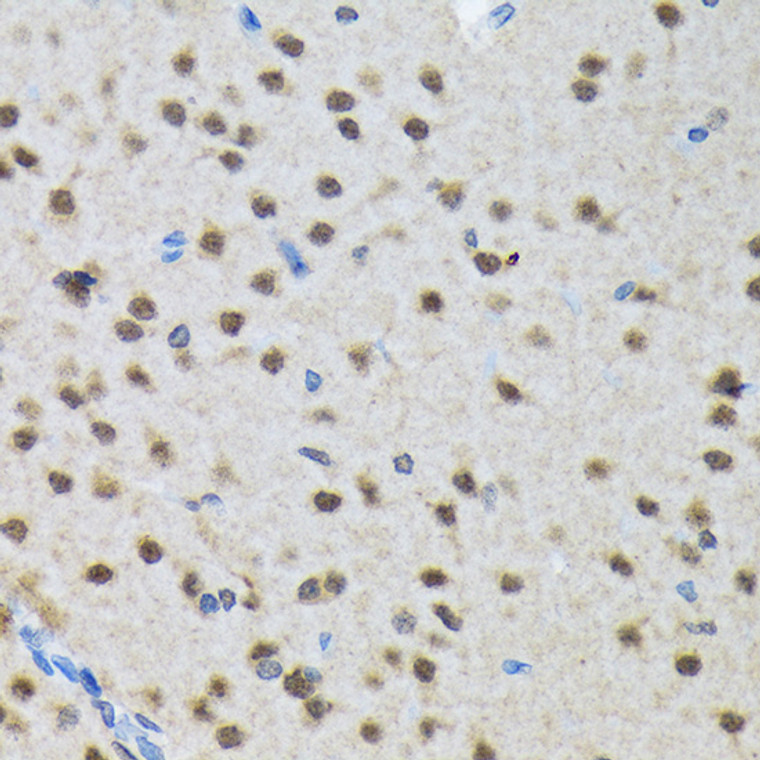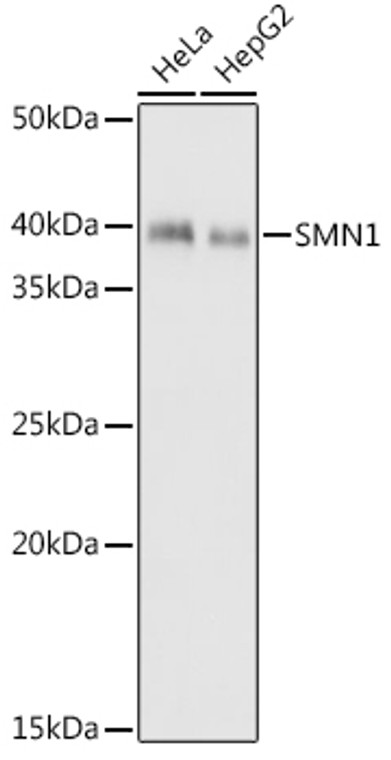| Host: |
Rabbit |
| Applications: |
WB/IHC |
| Reactivity: |
Human/Rat |
| Note: |
STRICTLY FOR FURTHER SCIENTIFIC RESEARCH USE ONLY (RUO). MUST NOT TO BE USED IN DIAGNOSTIC OR THERAPEUTIC APPLICATIONS. |
| Short Description: |
Rabbit monoclonal antibody anti-SMN1 (103-200) is suitable for use in Western Blot and Immunohistochemistry research applications. |
| Clonality: |
Monoclonal |
| Clone ID: |
S5MR |
| Conjugation: |
Unconjugated |
| Isotype: |
IgG |
| Formulation: |
PBS with 0.02% Sodium Azide, 0.05% BSA, 50% Glycerol, pH7.3. |
| Purification: |
Affinity purification |
| Dilution Range: |
WB 1:500-1:1000IHC-P 1:50-1:200 |
| Storage Instruction: |
Store at-20°C for up to 1 year from the date of receipt, and avoid repeat freeze-thaw cycles. |
| Gene Symbol: |
SMN1.SMN2 |
| Gene ID: |
6606/6607 |
| Uniprot ID: |
SMN_HUMAN |
| Immunogen Region: |
103-200 |
| Immunogen: |
Recombinant fusion protein containing a sequence corresponding to amino acids 103-200 of human SMN1 (Q16637). |
| Immunogen Sequence: |
SEDGCIYPATIASIDFKRET CVVVYTGYGNREEQNLSDLL SPICEVANNIEQNAQENENE SQVSTDESENSRSPGNKSDN IKPKSAPWNSFLPPPPPM |
| Tissue Specificity | Expressed in a wide variety of tissues. Expressed at high levels in brain, kidney and liver, moderate levels in skeletal and cardiac muscle, and low levels in fibroblasts and lymphocytes. Also seen at high levels in spinal cord. Present in osteoclasts and mononuclear cells (at protein level). |
| Function | The SMN complex catalyzes the assembly of small nuclear ribonucleoproteins (snRNPs), the building blocks of the spliceosome, and thereby plays an important role in the splicing of cellular pre-mRNAs. Most spliceosomal snRNPs contain a common set of Sm proteins SNRPB, SNRPD1, SNRPD2, SNRPD3, SNRPE, SNRPF and SNRPG that assemble in a heptameric protein ring on the Sm site of the small nuclear RNA to form the core snRNP (Sm core). In the cytosol, the Sm proteins SNRPD1, SNRPD2, SNRPE, SNRPF and SNRPG are trapped in an inactive 6S pICln-Sm complex by the chaperone CLNS1A that controls the assembly of the core snRNP. To assemble core snRNPs, the SMN complex accepts the trapped 5Sm proteins from CLNS1A forming an intermediate. Within the SMN complex, SMN1 acts as a structural backbone and together with GEMIN2 it gathers the Sm complex subunits. Binding of snRNA inside 5Sm ultimately triggers eviction of the SMN complex, thereby allowing binding of SNRPD3 and SNRPB to complete assembly of the core snRNP. Ensures the correct splicing of U12 intron-containing genes that may be important for normal motor and proprioceptive neurons development. Also required for resolving RNA-DNA hybrids created by RNA polymerase II, that form R-loop in transcription terminal regions, an important step in proper transcription termination. May also play a role in the metabolism of small nucleolar ribonucleoprotein (snoRNPs). |
| Protein Name | Survival Motor Neuron ProteinComponent Of Gems 1Gemin-1 |
| Database Links | Reactome: R-HSA-191859Reactome: R-HSA-9754678 |
| Cellular Localisation | NucleusGemCajal BodyCytoplasmCytoplasmic GranulePerikaryonCell ProjectionNeuron ProjectionAxonMyofibrilSarcomereZ LineColocalizes With Actin And At The Z-Line Of Skeletal MuscleUnder Stress Conditions Colocalizes With Rpp20/Pop7 In Punctuated Cytoplasmic GranulesColocalized And Redistributed With Zpr1 From The Cytoplasm To Nuclear Gems (Gemini Of Coiled Bodies) And Cajal BodiesColocalizes With Fmr1 In Cytoplasmic Granules In The Soma And Neurite Cell Processes |
| Alternative Antibody Names | Anti-Survival Motor Neuron Protein antibodyAnti-Component Of Gems 1 antibodyAnti-Gemin-1 antibodyAnti-SMN1 antibodyAnti-SMN antibodyAnti-SMNT.SMN2 antibodyAnti-SMNC antibody |
Information sourced from Uniprot.org
12 months for antibodies. 6 months for ELISA Kits. Please see website T&Cs for further guidance












